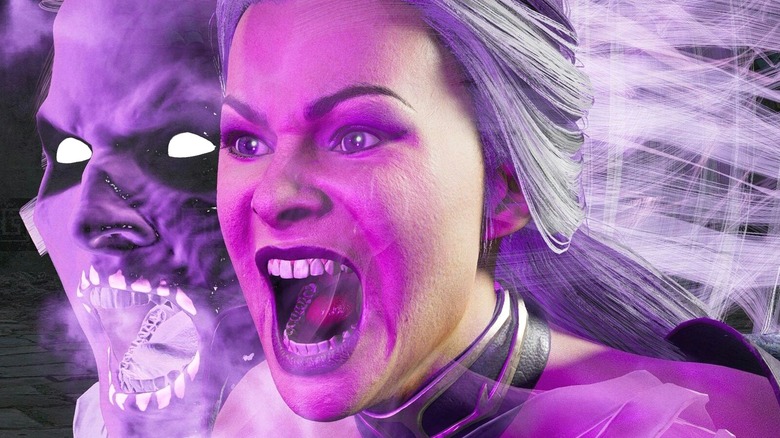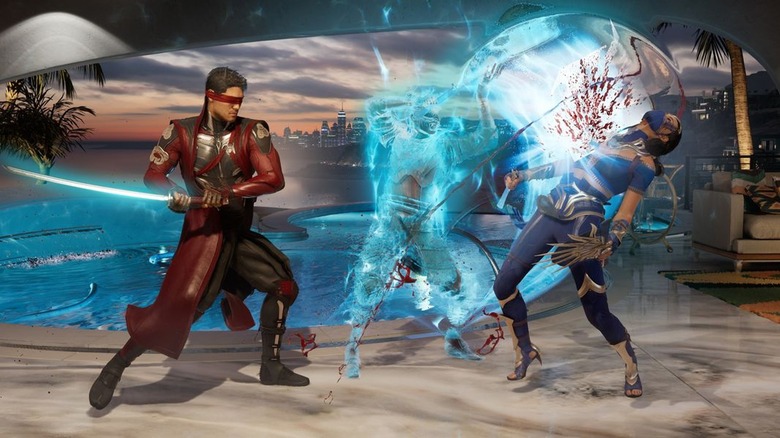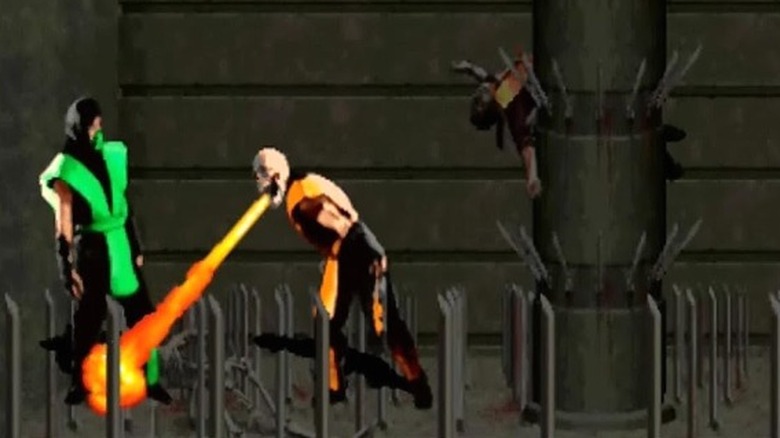Mortal Kombat Moments That Make Fans Rage Quit
"Mortal Kombat" may be best known for its gut-wrenching violence and Fatalities that include yanking out the spines of enemies, but a few entries in the series have been known to make players yank their own hair out, as well. The developers behind the "Mortal Kombat" series are well aware of how frustrating these games can be, which is why the last few entries have actually taken steps to poke fun at players who rage quit. If a player suddenly leaves an online match, they trigger a bloody "Quitality" that kills their character and ends the fight. It's a sight to see, not to mention extremely entertaining for the dedicated players who manage to stick things out.
Not every rage quit in this franchise stems from players being bad sports, however. Some players know to expect bonkers combos from their opponents and still enjoy seeing tournaments through to the end. But "Mortal Kombat," like many other long-running franchises, is not without its weak points. Players can also throw their hands up over buggy mechanics, janky controls, and downright baffling decisions from the creators. Here are some of the things that have made even the biggest "Mortal Kombat" fans jump ship.
Not being able to finish quests in Mortal Kombat 1
Although "Mortal Kombat 1" has been widely seen as a return to form for the "Mortal Kombat" franchise, its Daily and Weekly Quests have been a source of contention. Players are supposed to be able to earn in-game rewards by meeting certain requirements during play (landing a certain number of uppercuts in a day, pulling off a specific number of Fatalities per week, etc.), but many of these quests have been buggy and unresponsive. Players have complained of their accomplishments not registering, such as one player who said the number of uppercuts they landed kept resetting, making the quest impossible to turn in. Other players are reportedly able to complete all of their Daily Quests, only for the game to withhold the associated rewards.
Even worse, some players have encountered quests that simply cannot be carried out, due to their reliance on moves that aren't even in the game. One such Daily Quest asks players to perform two Mercy moves, even though Mercies were seemingly cut from "MK1" before release. Failing a quest is one thing, but making progress through your daily checklist and then discovering that the game is working against you is something altogether more frustrating. It's no wonder why some fans are already ignoring the Daily Quests in "Mortal Kombat 1."
Platforming in Mortal Kombat Mythologies: Sub-Zero
No matter which way you slice it, "Mortal Kombat Mythologies: Sub-Zero" is a true low point of the franchise. The 1997 game was one of a few early attempts to create spin-offs of the main "Mortal Kombat" series that embraced different gaming genres. In this case, "Mythologies: Sub-Zero" was more of beat-em-up with platforming sections — and it didn't work, to say the least. The game's level design added up to what Retronauts' review called "a laundry list of flaws that relegate it quite succinctly to the very lowest tier of franchise flops."
An early section of the game still haunts the dreams of everyone who played this game, and it involves everyone's favorite ice cold assassin, Sub-Zero, leaping between ruins in the Himalayas. The game's stiff, clunky controls and the character model's large size mean that every jump has to be pixel-perfect, or else Sub-Zero is going to be sent plummeting to his death. Adding to the frustration, there are times when the next ledge is just slightly off-screen, making more than a few of these jumps into true leaps of faith. In the years since its release, "Mythologies: Sub-Zero" has become infamous for its random unavoidable traps and repetitive enemies, but nothing gets the blood boiling quite like seeing the same animation of Sub-Zero falling into an abyss over and over and over again.
Failing a secret Kombatant unlock
The "Mortal Kombat" series has incorporated secret unlockable characters from the very beginning, starting with Reptile's appearance in 1992's "Mortal Kombat." Unlocking the mysterious green ninja in the original game was a laborious process: If a shadowy figure flies over the moon in the Pit stage, players have to achieve a Double Flawless Victory without blocking any of their opponent's attacks, then wrap things up with a Fatality. At this point, Reptile would appear and players could challenge him at the bottom of the Pit. Future "MK" games would include similarly convoluted character unlocks, like Meat from "MK4" (unlocked after playing as every character) and Cyber Sub-Zero in "Mortal Kombat X" (unlocked with a special button input while playing as Tri-Borg).
Since many of these characters are only unlocked after meeting very specific criteria, many "Mortal Kombat" players have experienced the sting of failing to find the hidden Kombatants. These unlocks can be super difficult for even the most well-practiced "MK" veterans. It's beyond frustrating to finally get a chance at unlocking Klassic Noob Saibot in "Mortal Kombat (2011)," only to accidentally block your opponent when muscle memory takes over, ruining the whole thing.
Getting knocked around by the Flash in MK vs. DC
Depending on who you ask, "Mortal Kombat vs. DC Universe" is better than its reputation suggests. Yes, it's weird that the game mostly excised the series' classically nasty Fatalities in favor of more "family-friendly" Brutalities, but the mechanics of the game are overall sound — unless you're going up against a particularly cheap (or skilled) Flash player, that is.
DC Comics fans know that the Flash is the Fastest Man Alive, and this game does a pretty solid job of replicating that exciting sense of speed. Most of his attacks are built around zipping around his opponents in a whirlwind of movement, keeping them disoriented and open to further strikes. One of his special moves involves running past the enemy multiple times and spinning them around, while another takes the form of a series of high-speed punches. Due to the sheer speed of Flash's moves, it can be especially difficult for newer players to counter or block them. If you find yourself going up against a Flash player who really knows what they're doing, the results can be truly devastating. It's hard not to feel a bit of rage brewing when the Flash gets you trapped in a combo that last for dozens of hits.
The death of Johnny Cage in Mortal Kombat: Annihilation
Yes, this is about a movie and not one of the video games, but it's no less a sore point for longtime "Mortal Kombat" fans. Linden Ashby's performance as self-obsessed action hero Johnny Cage is still seen one of the highlights of the 1995 "Mortal Kombat" film adaptation, which is why it's such a shame that the film's sequel did the character so dirty. Much like most of the returning characters from the first movie, the role of Johnny Cage was recast with a new actor. Chris Conrad took over the role from Linden Ashby, but that wasn't the main problem for fans of the original.
Despite being a fan-favorite character and one of the main heroes of the first film, Johnny enjoys just under a minute of screen time in 1997's "Mortal Kombat: Annihilation." He manages to speak a few words and fails to land a Shadow Kick before being quickly and brutally murdered by the villainous Shao Kahn. It's a moment that fans still see as a major misstep, one that the film never quite recovers from.
How did you feel when Johnny Cage died?
by
u/shonenhikada in
MortalKombat
Upon seeing their favorite character killed (not to mention recast) in such an unceremonious fashion, nobody would blame fans who walked out of the theater or popped their tape out of the VCR and never looked back. Considering how bad the rest of the movie is, the folks who rage quit this movie probably did themselves a favor.



